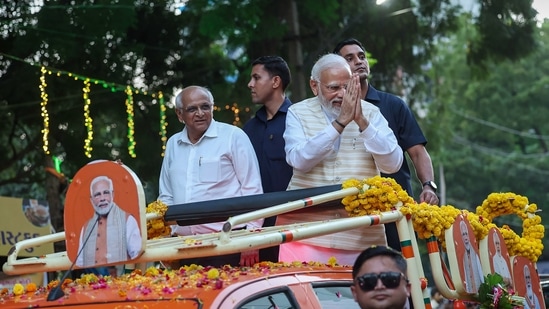5 years on, how state’s political arena changed in Gujarat
Political experts say the Patidar agitation has lost steam, that businesses have become accustomed to GST, and that the BJP has sought to counter anti-incumbency by replacing almost the entire cabinet in 2021 with Bhupendra Patel replacing Vijay Rupani as chief minister.
The ruling Bharatiya Janata Party (BJP) won 99 of the 182 assembly seats in 2017 Gujarat assembly elections, its worst performance since 1995; the year also saw the Congress’ best performance since 1985 -- the party won 77 seats. The majority mark is 92. The BJP has since, courtesy defections and by-elections, has taken its strength in the assembly to a comfortable 111.

The 2017 election took place against the backdrop of the violent agitation by Patidars demanding reservation in educational institutions and jobs, and from business communities suffering on account of teething problems in the implementation of the Goods and Services Tax (GST), and a significant sentiment against the incumbent that had been in power for 19 years at the time.
Five years down the line, the context of the 2022 assembly elections -- these will happen in two phases on December 1 and 5 -- is very different.
Political experts say the Patidar agitation has lost steam, that businesses have become accustomed to GST, and that the BJP has sought to counter anti-incumbency by replacing almost the entire cabinet in 2021 with Bhupendra Patel replacing Vijay Rupani as chief minister.
Also read: 'Kyuki Rahul ko hai bachana': BJP's swipe at Cong's '3 monkey' reaction on Gujarat poll
“Most of the burning issues of last elections are not visible this time,” said political expert Ghanshyam Shah.
He, however, added that unemployment and inflation are two major issues around which the elections are expected to be fought.
There is also another difference. Gujarat is set for a three-cornered electoral fight with the Aam Aadmi Party (AAP) looking to make inroads into Prime Minister Narendra Modi and Union home minister Amit Shah’s home state, where the BJP has been in power for around three decades with Congress as its main rival.
To be sure, many experts believe AAP’s gains could come at the cost of the Congress.
The Congress’s campaign has been lacklustre so far, and the party has lost 16 MLAs to the BJP in the last five years. A senior Congress leader in New Delhi claimed that their workers have reached 80% of households in the state in the past three months. The leader, who asked not to be named, did not present any evidence to substantiate his claim.
The Arvind Kejriwal-led Aam Aadmi Party (AAP) is looking for a foothold in Gujarat and has been running a visible and aggressive campaign. Kejriwal has visited the state at least twice every month since August and has sought to make corruption, education, healthcare and unemployment electoral issues, while promising free electricity, free education and a monthly stipend to unemployed young people . The party has declared candidates for 108 seats. The BJP and Congress are yet to name candidates.
The BJP is aiming to repeat or better its best performance of 127 seats in 2002 when Modi was the chief minister. The party believes that the current ground situation is favourable to it , as AAP is not a formidable force in the state and the Congress has weakened. “We have a strong cadre to get electoral benefit of Modi ji’s image,” said a Gujarat BJP leader who asked not to be named.
In 2017, the Congress had the backing of a dynamic trio of young leaders, Hardik Patel, Alpesh Thakore and Jignesh Mevani, who captured the imagination of young voters. Patel and Thakore have since joined the BJP. Mevani joined the Congress but his influence is said to be limited to a section of Dalits, who constitute 6.74% of the state’s population.
Hardik Patel led the agitation of Patidars, a once-dominant agrarian community, starting 2015 , demanding reservation for the community in jobs and educational institutions in the other backward classes (OBC) category. The agitation brought Patel into the national limelight . After the 2017 assembly polls the Patidar agitation had died down and many Patel leaders supporting Hardik Patel joined the BJP. In 2020 he was appointed working president of the Gujarat Congress. In June this year, he quit the Congress and joined the BJP.
Also read: Gujarat polls: Who will be AAP's CM face? All eyes on these two names
What also helped the Congress in 2017 was simmering discontent in the business community over GST . Congress leader Rahul Gandhi coined the term “Gabbar Singh Tax” during the Gujarat 2017 elections. Despite that, the BJP was able to sail through the urban business areas such as Surat and Vadodara, winning a majority of the seats . The Congress won most of its seats from rural Gujarat.
In the recent past, the Congress tried to convert allegations of the then Vijay Rupani led BJP government hiding deaths due to coronavirus in 2021 into a political issue and launched a Covid-19 Nyay Yatra in August 2021. The BJP was, however, able to diffuse the issue to some extent by replacing Rupani with Bhupendra Patel . To further offset anti-incumbency, a BJP leader familiar with the matter said that at least 30% of sitting MLAs could be dropped.
Ghanshyam Shah said, “Mismanagement of the state is another issue and it has been exemplified in the Morbi incident where questions have been raised about how administration works in collusion with vested interests. The issues about education and health care that were raised by Congress in 2017 are being raised by AAP in 2022.”






